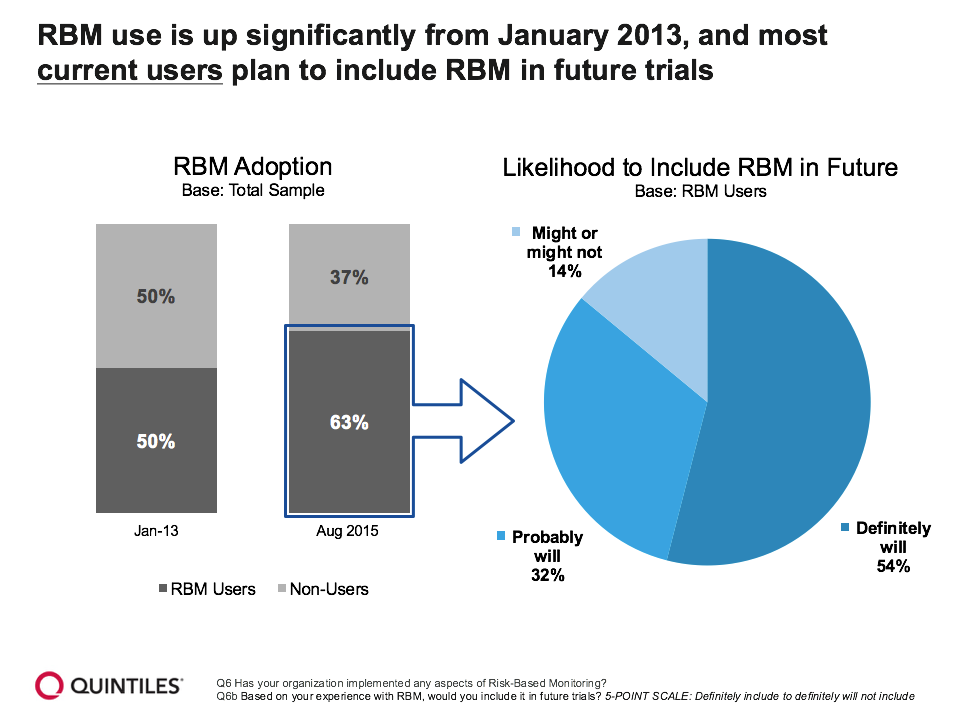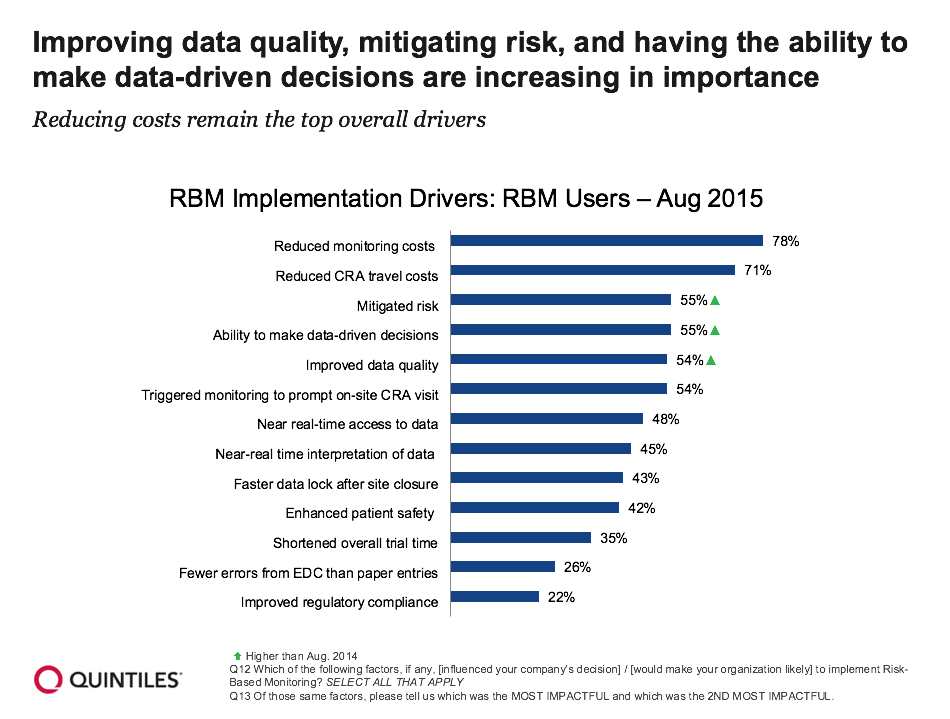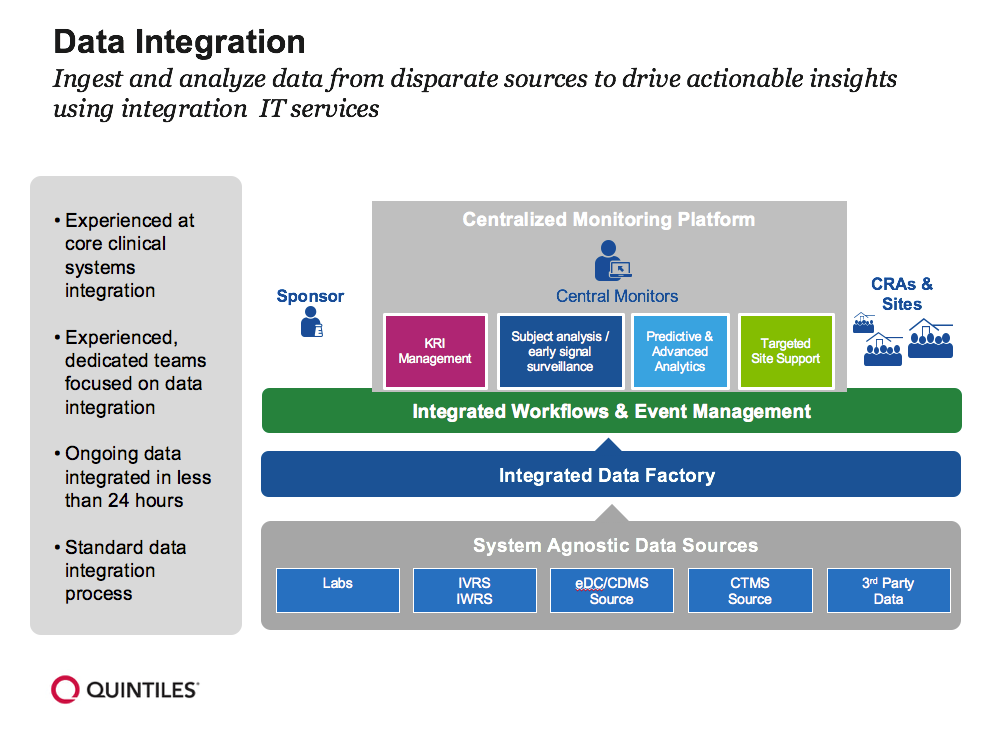The Core of RBM is Centralized Monitoring
The use and awareness of risk-based monitoring is now impacting clinical trials of all sizes, indications and types as a core component more than ever before. Sponsors and sites are expected to expand its use to include all phases of clinical research and all therapeutics areas.
Latest survey and research from Quintiles shows gains in RBM awareness and implementation
Recent research indicates that the implementation of risk-based monitoring (RBM) – particularly using centralized monitoring as a core component of clinical trial execution – is impacting clinical trials of all sizes, indications and phases. Based on lessons learned from 150-plus trials involving this approach, and a recent survey of biopharma executives,1 this article will describe current awareness and usage of RBM, key drivers and considerations, an approach to central monitoring as well as implementation challenges.
Awareness and usage of RBM
Awareness of this innovative approach is now close to universal, at 93% for unaided respondents and 96% for aided ones in a recent survey from August 2015 conducted with clinical outsourcing key decisions makers and influences within the pharma industry. Top-of-mind RBM descriptions from survey respondents included:
- Planning, with identification of key risk indicators (KRIs), and establishment of protocols for responding to KRI alerts
- Appropriate and efficient data monitoring: As one survey respondent explained, “It's actually using some of the technology that we have at our disposal like statistics and technology so that we can track quicker, have better feedback, diagnosis and actually fix the problem before it's too late.”
- Increasing data quality and actions through near real-time data monitoring: As another respondent noted, “It's the process of focusing on key data points for review and tracking of potential issues within a study. It's an overall view, ranking how important differencing data points are within a study and then assigning a strategic plan to monitor and clean those data points as the team agrees.”
- Fewer planned site visits.
RBM use is increasing, from around 50% in 2013 to 63% in 2015, with sponsors and sites expressing growing satisfaction of RBM trials and planning to expand their use (Figure 2). Most current users plan to include RBM in future trials, and over half of non-users plan to implement RBM within the next two years over a wide range of therapeutic areas, led by dermatology (32%), oncology (32%), biologics (27%), immunology (23%), allergy/respiratory (18%) and CNS (18%). To date, RBM has been used most often in Phase II through Phase IV studies, but RBM usage is also cited being used in Phase I, including Proof-of-Concept, studies.2
Figure 2: RBM adoption in August 2015 vs. January 2013

Key drivers and considerations
Key drivers for use of RBM are the potential to reduce monitoring costs (cited by 78% of respondents), mitigate risk (55%), enable data-driven decision-making (55%), improve data quality (54%), and use triggered monitoring to prompt an on-site CRA visit (54%; see Figure 3). For non-users, finding an appropriate trial is key, in addition to being made aware of CROs’ RBM experience – including technology and process implementations to help in selecting a suitable partner.
Figure 3: RBM implementation drivers among RBM users (August 2015; n=103)

Implementation
The most common new operational capability seen in successful implementation of RBM is some form of centralized monitoring. It’s increasingly clear that this capability is a core driver that is improving efficiencies, decision support and unlocking real value by fundamentally changing the way clinical monitoring is performed.
Successful implementation also requires data integration, enabling data from disparate sources to drive actionable insights using integrated IT services (Figure 4). Enhanced decision making based on data insights also clearly depends on sophisticated capabilities in data curation and technology platform management.
As shown in Figure 1, elements of centralized monitoring include:
- Key Risk Indicators (KRIs) and trigger management, is the most common element of a centralized monitoring solution, reviewing pre-defined triggers and alerts based on agreed thresholds to drive subsequent actions. This is very useful for driving elements like data flow, but have some limitations when it comes to identifying relative site risk or designing appropriate actions for multi trigger events.
- Predictive and advanced analytics, designed to identify where risks are and where they are likely to be at both the site and patient level. As shown in the green area of Figure 1, these combined inputs across multiple variables, including operational performance and study data to provide unprecedented insights for study monitoring. These analytics are the first such model-based capabilities fully integrated into an RBM approach and represent a major step forward in improving quality and productivity in the next generation of risk-based clinical research execution.
- Targeted site support, enabling improved protocol compliance, clinical data flow and site visit preparation as represented in the light blue area of Figure 1. Specific site performance metrics and information are provided to Clinical Research Associates (CRAs), identifying key actions to execute – optimizing each site visit and making site interactions more effective and efficient from all three perspectives of cost, quality and time.
- Subject-level data review/early signal surveillance, provides holistic review of critical subject data by medically-trained staff, and identifies clinical incongruences earlier to resolve potential eligibility and safety issues. The process – illustrated in dark blue in Figure 1 – also helps detect protocol compliance and subject retention issues.
Figure 1: Centralized monitoring: a core component of RBM

Demonstrating improved data quality and shorter time to make data-driven, key decisions has helped some biopharma companies overcome their initial lack of comfort surrounding reduced verification of all source data – a key component of RBM. Around half of companies surveyed plan to develop their own internal RBM solution: however, these companies will face new challenges with adapting roles, systems, and processes to implement and maximize RBM rather than working with a partner that has those systems, roles and processes in place already. Here, change management is a core consideration, and buy-in needs to be driven from executive levels.
Figure 4: Data integration in RBM

Conclusion
There’s no doubt that awareness and usage of RBM is increasing. Sponsors and sites are broadly satisfied with this approach and expect to expand its use to include all phases of clinical research and all therapeutic areas. Cost savings are key; however, mitigating risk, improving data quality, and enabling data-driven decisions are increasingly important drivers for RBM adoption. As technology continues to drive change, centralized monitoring has the promise to further improve efficiencies to change the way clinical monitoring is performed. New analytics capabilities can help clinical researchers assess the probability of a future event occurring -- for example, a protocol deviation that may require on-site action. The ability to cut through noise and predict potential risks before they occur means teams can optimally allocate current and future site management resources, as well as achieve enhanced patient safety and data quality at greater speed and lesser cost.
Martin Giblin is VP, Data Sciences, Safety & Regulatory, and Head, Risk-based Monitoring, at Quintiles.
References
- Quintiles surveys of pharmaceutical industry executives, January 2013 (n=115), August 2014 (n=101), and August 2015 (n=103)
- ISR 2015 RBM market assessment report
Unifying Industry to Better Understand GCP Guidance
May 7th 2025In this episode of the Applied Clinical Trials Podcast, David Nickerson, head of clinical quality management at EMD Serono; and Arlene Lee, director of product management, data quality & risk management solutions at Medidata, discuss the newest ICH E6(R3) GCP guidelines as well as how TransCelerate and ACRO have partnered to help stakeholders better acclimate to these guidelines.
Putting Collective Insights Into Action to Advance Cancer Care: Key Examples From ASCO 2025
June 27th 2025At ASCO 2025, clinical operations leaders gained critical insights into how AI tools, bispecific antibodies, and evolving treatment paradigms are reshaping trial design, endpoint selection, and patient stratification.